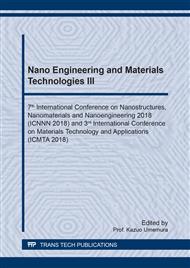p.148
p.155
p.160
p.167
p.173
p.178
p.185
p.190
p.195
Contact Angle Properties of Bioacrylic Palm Oil Based Polyol for Polyurethane Coating
Abstract:
Bio-acrylic palm oil based polyol was synthesized and characterized for polyurethane (PU) coating. In this project, acrylation of palm oil based polyol was done by using different amount of 2-hydroxyethyl methacrylate (HEMA) along with styrene mole ratio at 1:0.5:2, 1:1:2 and 1:1.5:2. The result shows that the increasing amount of HEMA content has increased the hydroxyl value. The characterization of bio-acrylic palm oil based polyol carried out by IR spectroscopic analysis and hydroxyl value. Coated surfaces were then characterized for the drying and gelling time, contact angle test and FTIR analysis were also reported. As the NCO/OH ratio of the coatings increased, there were progressive increased in mechanical and anticorrosive properties for all the coatings. Overall, this study showed that the material holds promise to be used as an effective HYPERLINK "https://www.sciencedirect.com/topics/materials-science/surface-coating" \o "Learn more about Surface Coating" surface coating compound by designing the formulation based on the desired performance.
Info:
Periodical:
Pages:
173-177
Citation:
Online since:
March 2019
Keywords:
Price:
Сopyright:
© 2019 Trans Tech Publications Ltd. All Rights Reserved
Share:
Citation:


